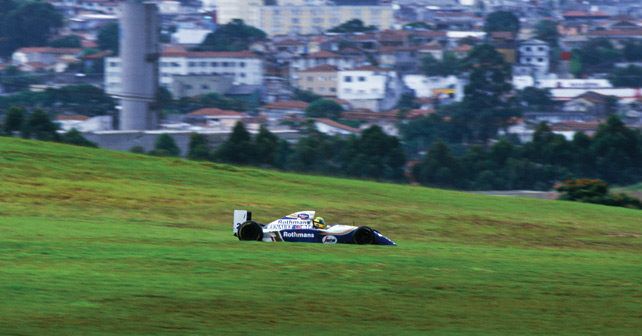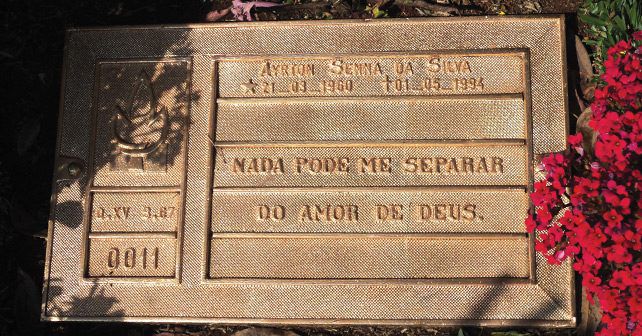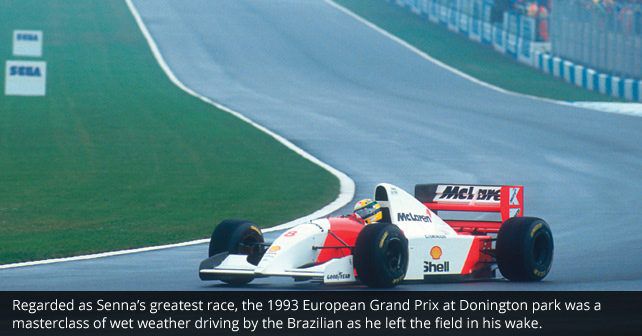A journey to pay tribute to F1’s fallen legend reveals that 23 years after his death he is very much in the thoughts of a nation and the sport.
Morumbi Cemetery in Sao Paulo is large, green and serene. The journey here, where one of Brazil’s most famous sons – Ayrton Senna – sleeps, has been emotionally draining.
Earlier, in Rio de Janeiro for the 2016 Olympics, I mentioned to Brazilian friends my intended pilgrimage to Senna’s grave. Livia Forte was intrigued; for her, an Indian, from a country an ocean and a continent away, paying tribute at Senna’s grave was worthy of a story on Portuguese-language TV.
I am a motorsport marshal, I explained, and then blurted out something that left her gobsmacked. “I saw the race at Imola in which Senna died, on TV. To this day I remember the view from Schumacher’s car, which was just behind. Senna’s car, instead of turning left, turned right and went straight into the wall. I’d never seen a crash live before. I thought he’d be injured, that’s all. When they announced he had died, I jumped to my feet.”
My recollection of the afternoon of May 1, 1994, which had such an impact on the world of Formula 1 that it ultimately served to make the racing safer, jogged another Brazilian’s memory. Cristina Daneze Wollenberg turned dreamy-eyed as she recalled, “My father was a Senna fan. In my childhood, we would wake up on Sundays so excited because Senna was going to make Brazil feel proud.”
The Senna legacy still makes Brazil proud – and many people speak less about the three world championship titles he won in 1988, 1990 and 1991 than about the Instituto Ayrton Senna run by his sister, Viviane Senna. The institute, a charitable venture, was set up by the Senna family after his death to provide opportunities to Brazil’s underprivileged youngsters and I hope to visit it in Sao Paulo’s Pinheiros locality someday.
For the moment, though, my thoughts return to the mourning that engulfed Brazil after Senna’s death. My taxi driver, Reinaldo, pointed out the name of the highway from Guarulhos airport into the city: Rodovia Ayrton Senna. This is the road that was lined by three million people when his body came home.
The ride to the cemetery has taken the better part of an hour and Reinaldo has showed me Sao Paulo’s football clubs, heritage Portuguese architecture and the Senna memorial as we zipped past. The cityscape changed from suburban to skyscrapered business and then we were in a leafy, residential area with palatial houses behind tall boundary walls. Soon, we drew up at the cemetery.
Now, Reinaldo parks and asks a cemetery staffer the way to Senna’s grave. But first I walk to the flower shop at the cemetery entrance. Clutching a tub of flowers, I feel a lump rising in my throat. Then Reinaldo strides across the grass and I follow.
The grass is dotted with plaques, some with flowers around them. Suddenly, he stops at one. “This is it,” he says. “It can’t be,” is my response.
“It is. Look, his name is on it.” Ayrton Senna da Silva. Those heart-wrenching dates, signifying a lifetime of 34 years. A line in Portuguese that is seared into the minds of Senna fans worldwide – Nada pode me separar do amor de Deus (Nothing can separate me from the love of God).
I realise I had expected some sort of sequestered shrine, perhaps a sarcophagus. There is nothing to distinguish it from the other graves, many of which have similar brass plaques, glinting rose-gold in the sunshine.
I place my flowers. I also leave something from India’s Buddh International Circuit at the grave – a fridge magnet that was part of the marshal kit for the 2012 Indian Formula 1 Grand Prix.
We linger, gazing at the grave, dappled with shade by the branches of a tree overhead. “Twenty-two years,” I murmur. “I was 17, I was on the beach when I got the news,” mutters Reinaldo. The sadness is overwhelming. Finally, we tear ourselves away.
































Write your Comment